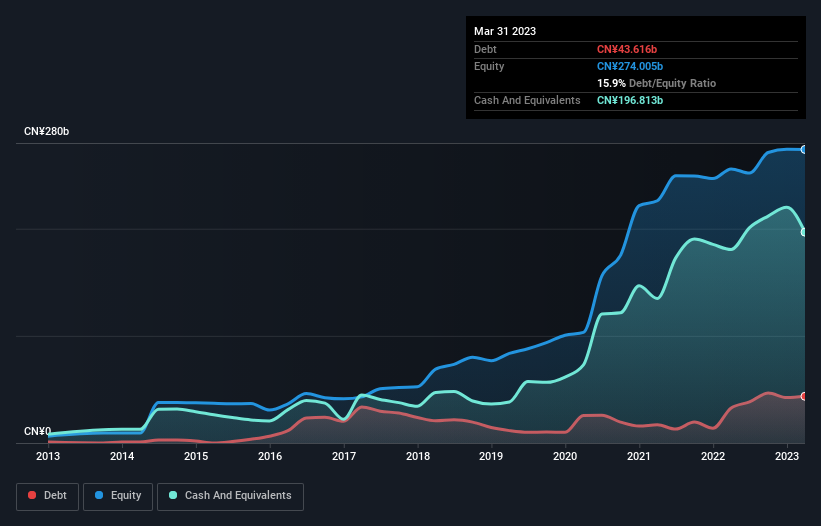Is JD.com (NASDAQ:JD) A Risky Investment?
Howard Marks put it nicely when he said that, rather than worrying about share price volatility, 'The possibility of permanent loss is the risk I worry about... and every practical investor I know worries about.' When we think about how risky a company is, we always like to look at its use of debt, since debt overload can lead to ruin. Importantly, JD.com, Inc. (NASDAQ:JD) does carry debt. But the real question is whether this debt is making the company risky.
When Is Debt Dangerous?
Debt and other liabilities become risky for a business when it cannot easily fulfill those obligations, either with free cash flow or by raising capital at an attractive price. Ultimately, if the company can't fulfill its legal obligations to repay debt, shareholders could walk away with nothing. However, a more common (but still painful) scenario is that it has to raise new equity capital at a low price, thus permanently diluting shareholders. Of course, the upside of debt is that it often represents cheap capital, especially when it replaces dilution in a company with the ability to reinvest at high rates of return. When we think about a company's use of debt, we first look at cash and debt together.
Check out our latest analysis for JD.com
What Is JD.com's Debt?
You can click the graphic below for the historical numbers, but it shows that as of March 2023 JD.com had CN¥43.6b of debt, an increase on CN¥32.8b, over one year. However, it does have CN¥196.8b in cash offsetting this, leading to net cash of CN¥153.2b.
A Look At JD.com's Liabilities
According to the last reported balance sheet, JD.com had liabilities of CN¥224.2b due within 12 months, and liabilities of CN¥52.9b due beyond 12 months. On the other hand, it had cash of CN¥196.8b and CN¥20.9b worth of receivables due within a year. So its liabilities total CN¥59.3b more than the combination of its cash and short-term receivables.
Since publicly traded JD.com shares are worth a very impressive total of CN¥410.4b, it seems unlikely that this level of liabilities would be a major threat. However, we do think it is worth keeping an eye on its balance sheet strength, as it may change over time. While it does have liabilities worth noting, JD.com also has more cash than debt, so we're pretty confident it can manage its debt safely.
Even more impressive was the fact that JD.com grew its EBIT by 420% over twelve months. If maintained that growth will make the debt even more manageable in the years ahead. The balance sheet is clearly the area to focus on when you are analysing debt. But it is future earnings, more than anything, that will determine JD.com's ability to maintain a healthy balance sheet going forward. So if you want to see what the professionals think, you might find this free report on analyst profit forecasts to be interesting.
Finally, a company can only pay off debt with cold hard cash, not accounting profits. While JD.com has net cash on its balance sheet, it's still worth taking a look at its ability to convert earnings before interest and tax (EBIT) to free cash flow, to help us understand how quickly it is building (or eroding) that cash balance. Happily for any shareholders, JD.com actually produced more free cash flow than EBIT over the last three years. That sort of strong cash conversion gets us as excited as the crowd when the beat drops at a Daft Punk concert.
Summing Up
Although JD.com's balance sheet isn't particularly strong, due to the total liabilities, it is clearly positive to see that it has net cash of CN¥153.2b. The cherry on top was that in converted 161% of that EBIT to free cash flow, bringing in CN¥15b. So is JD.com's debt a risk? It doesn't seem so to us. When analysing debt levels, the balance sheet is the obvious place to start. But ultimately, every company can contain risks that exist outside of the balance sheet. Be aware that JD.com is showing 2 warning signs in our investment analysis , you should know about...
If you're interested in investing in businesses that can grow profits without the burden of debt, then check out this free list of growing businesses that have net cash on the balance sheet.
Have feedback on this article? Concerned about the content? Get in touch with us directly. Alternatively, email editorial-team (at) simplywallst.com.
This article by Simply Wall St is general in nature. We provide commentary based on historical data and analyst forecasts only using an unbiased methodology and our articles are not intended to be financial advice. It does not constitute a recommendation to buy or sell any stock, and does not take account of your objectives, or your financial situation. We aim to bring you long-term focused analysis driven by fundamental data. Note that our analysis may not factor in the latest price-sensitive company announcements or qualitative material. Simply Wall St has no position in any stocks mentioned.



